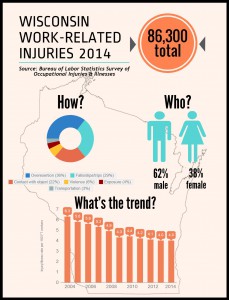According to estimates from the U.S Bureau of Labor Statistics’ Survey of Occupational Injuries and Illnesses (SOII), Wisconsin’s overall incidence rate of nonfatal occupational injuries and illnesses remained unchanged, at 4.0 cases per 100 equivalent full-time workers in 2014.
Nationally, the total injury and illness case rate per 100 full-time workers fell from 3.5 in 2013 to 3.4 in 2014. In surrounding Midwestern states (IA, IL, IN, MI, MN, NE, OH), Iowa had the highest total recordable case rate of 4.4 cases per 100 full-time workers while Ohio had the lowest rate of 2.9 cases.
SOII is the largest work injury data collection conducted nationwide. The Wisconsin SOII program collects data from a representative sample of 6,000 establishments in both the private and public sector.
- Private industry total incident rates fell slightly from 4.0 in 2013 down to 3.9 cases per 100 workers in 2014, while state and local government rates rose from 4.5 in 2013 to 4.7 in 2014.
- There were an estimated 86,300 total injuries and illnesses in Wisconsin workers with 25,300 (29%) requiring time off due to injury. The number of cases with time off due to injury is up from the estimated 23,200 in 2013.
- Across all industries, Wisconsin workers averaged 7 days off due to injury.
- The leading nature of injury that required time off work in the private sector was sprains, strains and tears at 37.8% of lost time injuries. Soreness and pain was the second leading cause, at 16.3% of lost time cases.
- Establishments with between 50 to 249 employees had the highest rate of workers who had time off due to injury at 4.7 cases per 100 full-time workers. Employers with between 11 to 49 employees were second-highest, with a rate of 4.1 cases per 100 full-time workers.
The Wisconsin State Laboratory of Hygiene, a part of the University of Wisconsin-Madison, is the state’s public, environmental and occupational health laboratory. The WSLH’s Bureau of Labor Statistics/Occupational Safety and Health Statistics Unit have a cooperative agreement with the U.S. Bureau of Labor Statistics to conduct their annual Survey of Occupational Injuries and Illnesses and Census of Fatal Occupational Injuries in Wisconsin.
For more information about nonfatal work injuries in Wisconsin, go to www.slh.wisc.edu/bls.

